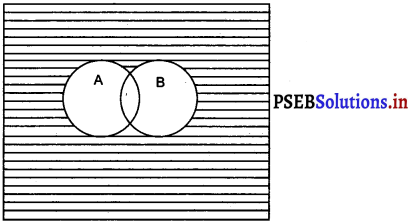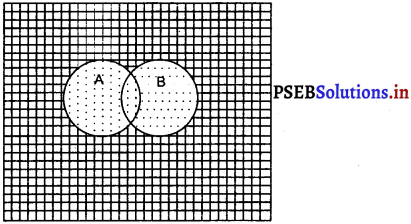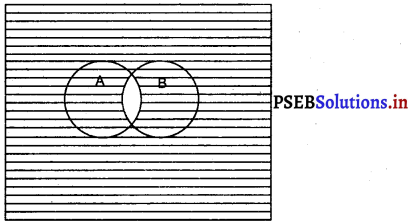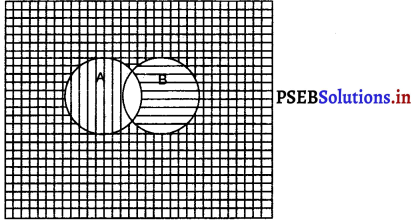Punjab State Board PSEB 11th Class Maths Book Solutions Chapter 1 Sets Ex 1.5 Textbook Exercise Questions and Answers.
PSEB Solutions for Class 11 Maths Chapter 1 Sets Ex 1.5
Question 1.
Let U = {1, 2, 3; 4, 5, 6, 7, 8, 9}, A = {1, 2, 3, 4}, B= {2, 4, 6, 8} and C = {3, 4, 5, 6}. Find
(i) A’
(ii) B’
(iii) (A ∪ C)’
(iv) (A ∪ B)’
(v) (A’)’
(vi) (B – C)’
Answer.
U = {1, 2, 3, 4, 5, 6, 7, 8, 9};
A = {1, 2, 3, 4};
B = {2, 4, 6, 8};
C = {3, 4, 5, 6}
(i) A’ = U – A
= {1, 2, 3, 4, S, 6, 7, 8, 9} – {1, 2, 3, 4} = {5, 6, 7, 8, 9}
(ii) B’ = {1, 2, 3, 4, 5, 6, 7, 8, 9} – {2, 4, 6, 8} = {1, 3, 5, 7, 9}
(iii) (A ∪ C) = {1, 2, 3, 4} ∪ {3, 4, 5, 6} = {1, 2, 3, 4, 5, 6}
(A ∪ C)’ = {1, 2, 3, 4, 5, 6, 7, 8, 9} – {1, 2, 3, 4, 5, 6} = {7, 8, 9}
(iv) (A ∪ B) = {1, 2, 3, 4} ∪ {2, 4, 6, 8} = {1, 2, 3, 4, 6, 8}
(A ∪ B)’ = {1, 2, 3, 4, 5, 6, 7, 8, 9} – {1, 2, 3, 4, 6, 8} = {5, 7, 9}
(v) A’ = {1, 2, 3, 4, 5, 6, 7, 8, 9} – {1, 2, 3, 4} = {5, 6, 7, 8, 9}
(A0′ = {1, 2, 3, 4, 5, 6, 7, 8, 9} – {5, 6, 7, 8, 9} = {1, 2, 3, 4}
(vi) B – C = {2, 4, 6, 8} – {3, 4, 5, 6} = {2, 8}
(B – C)’ = {1, 2, 3, 4, 5, 6, 7, 8, 9} – {2, 8} = {1, 3, 4, 5, 6, 7, 9}.
Question 2.
If U = {a, b, c, d, e, f, g, h}, find the complements of the following
(i) A={«, b, c}
(ii) B={d, e,f, g}
(iii) C={o, c, e, g}
(iv) D={f, g, h, a}
Answer.
(i) A’ = U – A = {a, b, c, d, e, f, g, h} – {a, b, c} = {d, e, f, g, h}
(ii) B’={a, b, c, d, e, f, g, h} – {d, e, f, g} = {a, b, c, h}
(iii) C’ = {a, b, c, d, e, f, g, h} – {a, c, e, g} = {b, d, f, h}
(iv) U = {a, b, c, d, e, f, g, h} – {f, g, h, a} = {b, c, d, e}.
Question 3.
Taking the set of natural numbers as the universal set, writedown the complements of the following sets:
(i) {x : x is an even natural number}
(ii) {x : x is an odd natural number}
(iii) {x : x is a positive multiple of 3}
(iv) {x : x is a prime number}
(v) {x: x is a natural number divisible by 3 and 5}
(vi) {x : x is a perfect square}
(vii) {x : x is perfect cube}
(viii) (x : x + 5 = 8}
(ix) {x : 2x + 5 = 9}
(x) {x : x ≥ 7}
(xi) {x : x ∈ N and 2x + 1 > 10}
Answer.
U = N : Set of natural numbers
(i) {x : x is an even natural number}’ = {x : x is an odd natural number}
(ii) {x : x is an odd natural number}’ = {x : x is an even natural number}
(iii) {x : x is a positive multiple of 3}’ = {x : x ∈ N and x is not a multiple of 3}
(iv) {x : x is a prime number}’ = {x : x is a positive composite number and x = 1}
(v) {x : x is a natural number divisible by 3 and 5}’ = {x : x is a natural number that is not divisible by 3 or 5}
(vi) {x : x is a perfect square}’ = {x : x ∈ N and x is not a perfect square}
(vii) {x : x is a perfect cube}’ = {x : x ∈ N and x is not a perfect cube}
(viii) {x : x + 5 = 8}’ = {x : x ∈ N and x ≠ 3}
(ix) {x : 2x + 5 = 9}’ = {x: x ∈ N and x ≠ 2}
(x) {x : x ≥ 7}’ = {x : x ∈ N and x < 7} (xi) {x : x ∈ N and 2x + 1 > 10}’ = {x : x ∈ N and x < 9/2}.
Question 4.
If U = {1, 2, 3, 4, 5, 6, 7, 8, 9}, A = {2, 4, 6, 8} and B = {2, 3, 5, 7}.Verify that
(i) (A ∪ B)’ = A’ ∩ B’
(ii) (A ∩ B)’= A’ ∪ B’ .
Answer.
U = {1, 2, 3, 4, 5, 6,7, 8, 9}
A = {2, 4, 6, 8}, B = {2, 3, 5, 7}
(i) (A ∪ B)’ = {2, 3, 4, 5, 6, 7, 8}’ = {1, 9}
A’ = {1, 3, 5, 7, 9}
B’ = {1, 4, 6, 8, 9}
A’ ∩ B’ = {1, 3, 5, 7, 9} ∩ {1, 4, 6, 8, 9} = {1, 9}
(A ∪ B)’ = A’ ∩ B’
(ii) (A ∩ B)’ = {2}’ = {1, 3, 4, 5, 6, 7, 8, 9}
A’ ∪ B = {1, 3, 5, 7, 9} ∪ {1, 4, 6, 8, 9}
= {1, 3, 4, 5, 6, 7, 8, 9}
(A ∩ B)’ = A’ ∪ B’
Question 5.
Draw appropriate Venn diagram for each of the foUowing:
(i) (A ∪ B)’
(ii) A’ ∩ B’
(iii) (A ∩ B)’
(iv) A’ ∪ B’
Answer.
(i) Shaded Area (A ∪ B)’

(ii) A’ ∩ B’ = Common shaded area

(iii) (A ∩ B)’ shaded Area

(iv) A’ ∪ B’ All shaded area formed by all horizontal and vertical lines.

Question 6.
Let U be the set of all triangles in a plane. If A is the set of all triangles with at least one angle different from 60°, what is A?
Answer.
A’ is the set of all equilateral triangles.
Question 7.
Fill in the blanks to make each of the following a true statement:
(i) A ∪ A’ = ……….
(ii) A’ ∩ A = ………
(iii) A ∩ A’= ………
(iv) A’ ∩ A = ………
Answer.
(i) A ∪ A’= U
(ii) Φ’ ∩ A = U ∩ A = A
(iii) A ∩ A’ = Φ
(iv) U’ ∩ A = Φ ∩ A = Φ
